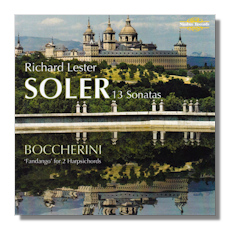
The Internet's Premier Classical Music Source
Related Links
-
Boccherini Reviews
Soler Reviews - Latest Reviews
- More Reviews
-
By Composer
-
Collections
DVD & Blu-ray
Books
Concert Reviews
Articles/Interviews
Software
Audio
Search Amazon
Recommended Links
Site News
 CD Review
CD Review
Antonio Soler

13 Sonatas
- Antonio Soler:
- Sonata in D Major, R. 86
- Sonata in D minor, R. 24
- Sonata in C Sharp minor, R. 21
- Sonata in D Flat Major, R. 110
- Sonata in A minor, R. 118
- Sonata in C minor, R. 19
- Sonata in C Major M27
- Sonata in F Major, R. 56
- Sonata in D Major, R. 92d
- Sonata in D minor, R. 39
- Sonata in G minor M38
- Sonata in D Major, R. 74
- Sonata in G Major, R. 43
- Luigi Boccherini: Fandango for 2 Harpsichords 1
Richard Lester, harpsichord
1 David Ponsford, harpsichord
Nimbus NI5906
The Catalan composer, Antonio Soler, was born in 1729 and lived to 1783. He came from a musical family; his formal musical training began when he was six – in the Escolania of the Monastery of Montserrat. At the early age of 14 Soler became both organist and subdeacon at the Cathedral of La Seu d'Urgell. By 1752 he was at the equally famous and prestigious Escorial in Madrid. There he studied with – amongst others – Scarlatti. And, for all his isolation, was exposed to visiting musicians and other traditions than those of metropolitan Spain.
The music on this exciting and enticing CD from Nimbus is expertly executed by Richard Lester. We soon hear many of the qualities which are to be inferred from knowing only that much about Soler's life. There is a flare to the British performer's playing from the very first bar of the first of the 13 harpsichord sonatas included. As with Scarlatti, we suspect that many of Soler's over 150 keyboard pieces (from more than 500 compositions in all) were written specifically for a certain pupil: the Infante Don Gabriel, a son of King Carlos III.
There is also a perhaps unexpected worldliness and sense of looking outward in Lester's style, which is highly appropriate to the music – and truly brings it to life. This is more delight, confidence, joie de vivre than plain extroversion… the leaps in the C Sharp minor, R21 [tr.3], for instance, are packed with energy. At the same time, Lester quietly yet purposefully marks Soler's sensitivity and almost wistful reflexion – in the modulations of key in the D flat Major, R110 [tr.4], for example. His playing suggests a richness of melodic and harmonic invention that ought to make Soler better known than he is. The chromaticism and sense of tonal "reach" (and confidence) as he strides up and down the keyboard throughout the A minor, R118 [tr.5] set this music apart from many a later Baroque keyboard effort.
Lester has a remarkable talent for bringing such music completely alive, of seeing it from many sides. At the same time as he respects its integrity in every way, he plays it with a freshness and pungency, an attack yet a grace as though it were written yesterday and he had just ended a consultation with the composer. Listen to the rubato in the opening of the C minor, R19 sonata [tr.6], for example. Lester's is playing that sounds both exploratory – almost painstakingly experimental, with the addition of wonder – and technically still very much in control of the music. And hence at one with it, letting its lifeblood flow where it should.
Lester observes three categories into which we can fit the sonatas on this CD: those redolent of or derived from or intended for dance. A slower, more lyrical style with a tinge of (Andalusian) folk music. And those influenced by the galant style which was gaining ground in Soler's lifetime. Even had he chosen not to select works from these quite different sound experiences, the sense of variety is so strong that, as each sonata finishes, you're left eagerly waiting to see which delights the next will bring. It's a tribute to Lester's playing that not once could you imagine being consequently disappointed. Nor are you. These are thrilling, competent and altogether persuasive performances.
Lester is joined by David Ponsford for five minutes of what you might expect to be mere fun: the Fandango by Boccherini [tr.14]; this is Lester's own arrangement of the famous last movement of the Quintet number 4 in D Major, G448. It makes an impactful and memorable finale to a splendid CD. Fireworks take second place, though, to direction. The performance concentrates on this familiar music's beauty and elegance rather than its spectacle.
The acoustic of the CD leaves nothing to chance: the harpsichords are neither too close and mechanical nor too showy. They're three modern copies of contemporary Spanish, Portuguese and Italian originals (Ponsford's are copies of French and German ones). The booklet has essays by Lester offering just the right amount of information for an enthusiast and/or specialist as well as drawing those new to this delightful world in. Lovers of the Baroque keyboard will want to add this to their collection without hesitation. Lester's repertoire and enthusiasms extend to modern music as well as the period represented on this generous (at almost an hour and a quarter) CD. It's evident that aspiring keyboard players will gain much from immersing themselves in its variety, style and brilliance; as will those listeners who appreciate thoroughly communicative playing of the highest quality. Recommended.
Copyright © 2013, Mark Sealey


















